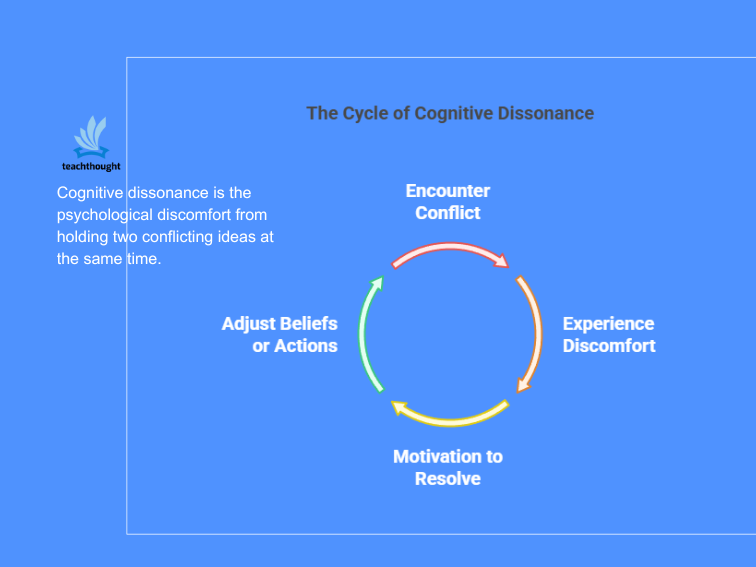What Is Cognitive Dissonance? A Definition For Teaching
Understanding Cognitive Dissonance: A Psychological Framework for Growth and Learning
As human beings, we strive for consistency–and alignment between their thoughts, beliefs, and actions.
When an inconsistency arises—when beliefs and behaviors clash—it creates a sense of discomfort or tension known as cognitive dissonance.
This concept, first introduced by psychologist Leon Festinger in 1957, provides insight into how humans respond to conflict within themselves and how they work to resolve internal contradictions. Its implications stretch across fields like psychology, decision-making, behavior modification, and, crucially, education.


What Is Cognitive Dissonance?
Cognitive dissonance is the psychological discomfort that arises when an individual encounters a conflict between what they believe and how they behave, or between two competing beliefs. This mental tension arises because human beings are wired to seek alignment between their cognition (beliefs, attitudes, knowledge) and their behavior. When dissonance occurs, it acts as a motivator to address and resolve the inconsistency.
For example, a student who values academic achievement but fails to study for an upcoming test experiences dissonance. Their belief, “Studying is important for success,” conflicts with their behavior of procrastination. This tension prompts them to take action—either by changing their behavior (studying) or by rationalizing it (“This test isn’t that important”).
How Does Cognitive Dissonance Work?
Cognitive dissonance operates as a psychological self-regulation tool, pushing individuals to restore harmony between conflicting thoughts or behaviors. People typically respond to cognitive dissonance in one of three ways:
- Changing Beliefs: Adjusting one’s view to make it compatible with their behavior.
Example: Instead of believing that hard work leads to success, a student might conclude that external factors, like luck, matter more. - Changing Behaviors: Aligning one’s actions with pre-existing beliefs.
Example: A student who procrastinates on studying decides to set aside time to prepare after acknowledging the importance of their effort in the classroom. - Rationalizing the Conflict: Adding new justifications to resolve the tension without changing beliefs or behaviors.
Example: A teacher justifies cutting corners on lesson prep by telling themselves, “I’m more effective when I teach on the fly.”
The brain’s goal is to reduce the dissonance as efficiently as possible, and the method chosen often depends on which option is easiest or least threatening to one’s sense of identity.
Cognitive Dissonance in Education
In teaching and learning environments, cognitive dissonance often occurs when students or educators encounter new information or experiences that challenge their existing beliefs or practices. While this discomfort might feel unproductive at first, it is actually a powerful tool for growth.
Here are three key ways cognitive dissonance manifests in education:
1. Promoting Critical Thinking
Students who are confronted with new ideas or evidence that contradict their existing understanding often experience cognitive dissonance. For example, a middle school science student learning about climate change might struggle to reconcile their family’s routine use of disposable plastics with the new knowledge that plastic pollution harms ecosystems. This tension forces the student to either reject or integrate the new information, encouraging deeper inquiry into the topic.
Teachers can intentionally create these “productive discomfort” moments by presenting open-ended questions, challenging assumptions, or introducing dilemmas relevant to students’ lives. When students reflect on how their beliefs align—or don’t align—with the evidence, they engage in critical thinking and develop more complex, nuanced perspectives.
2. Encouraging Behavioral Change
Cognitive dissonance highlights the gap between beliefs and actions, motivating students to adapt their behavior to align with their values. For instance, high schoolers who feel passionate about environmental sustainability but regularly litter might change their habits after reading a persuasive essay on the consequences of pollution. Similarly, a student who believes in the importance of punctuality but repeatedly misses deadlines may begin using organization tools to avoid these inconsistencies.
Educators can leverage this phenomenon through interventions and goal setting. When students recognize how their current behavior undermines their goals, they are more likely to take actions to create harmony.
3. Improving Educator Practices
Cognitive dissonance isn’t limited to students; educators experience it as well. A teacher might believe in the value of differentiated instruction but feel overwhelmed by time constraints, reverting to a one-size-fits-all approach. This clash between belief and practice can prompt reflection, leading the teacher to seek small, manageable ways to incorporate differentiation into their routines.
Professional development often leverages cognitive dissonance by introducing strategies or evidence that push teachers to examine and question their current approaches. For example, learning about the positive impact of student-centered learning might motivate teachers to adjust their instructional practices.
Overcoming Cognitive Dissonance in the Classroom
While cognitive dissonance can be a powerful driver of change, it can also lead to resistance or defensiveness if left unmanaged. Here are some strategies educators can use to help students and colleagues productively navigate dissonance:
- Normalize Discomfort: Reassure students and peers that it’s okay to feel uncomfortable when encountering new ideas. Frame cognitive dissonance as a natural, even healthy, part of learning and growth.
- Foster Reflection: Encourage students to ask questions like, “Why do I feel conflicted?” or “How can I align my actions with my beliefs?” Journals, discussions, or self-assessments can create space for this reflection.
- Support Change Gradually: Instead of expecting immediate transformation, provide opportunities for small, manageable steps toward resolving inconsistency.
- Provide Evidence and Counterexamples: The more information students and colleagues have access to, the better equipped they are to evaluate their assumptions and act thoughtfully.
Conclusion
Cognitive dissonance is a psychological phenomenon that occurs when beliefs, values, or actions contradict one another, creating a sense of mental discomfort. While this tension can be unsettling, it is also often ’causes’ or promotes reflection, change, and critical thinking. For educators, understanding cognitive dissonance offers an opportunity to create a learning environment where students feel challenged but supported as they confront inconsistencies in their thoughts and behaviors.
What Is Cognitive Dissonance? A Definition For Teaching

